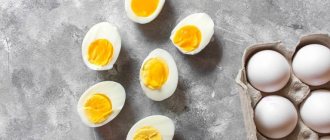Types of eggs and their calorie content
The popularity of the product is explained by its high taste characteristics and benefits for the body. In modern cooking, there are dozens of options for their preparation - from modest fried eggs to masterpieces of confectionery art.
Photo: adayinthekitchen.com
Eggs are easy to digest, and their chemical composition is rich in valuable elements and vitamins. This is one of the few components of the diet that is absorbed in almost 100% volume.
Several types of eggs are in demand among consumers:
- Chicken is a classic of the genre and a hit in the budget consumer basket. The nutritional value of 1 chicken egg in nutrition is equal to 100 g of meat. They are found with white and brown shells. The color of the shell matches the chicken's plumage. The average weight of 1 piece is 70 g.
- Quail eggs occupy 2nd place in terms of prevalence. They are fattier than chicken, but less allergenic. They are considered an environmentally friendly product, since poultry requires careful treatment and a thoughtful menu of harmless “chemicals”. The small egg is protected by a speckled shell and weighs about 17 g.
- Goose egg is a product with an expressive taste and powerful antioxidant properties. It is useful for strengthening the immune system and is actively used in cooking. Sold only at farmers' markets. The average weight of 1 copy is 200 g.
- Turkey eggs are similar in appearance and nutritional value to their chicken counterparts. The main difference is the higher fat content. Turkeys lay few eggs and seasonally, so their eggs are purchased individually by contacting the farmer-breeder. Weight of 1 piece – 70-72 g.
- Ostrich eggs are large exotic specimens. Giant size and bright taste are their key features. The weight of eggs depends on the breed of ostrich. A common indicator is 1600 g.
One ostrich egg can feed a company of 10 people.
Photo: quora.com
- Egg powder, or melange (from the French mélange - mixture) - dried and crushed whites and yolks of ordinary eggs. It is used for preparing dishes - omelettes, pastries, cutlets. The advantages of dry mixture over fresh eggs are a long shelf life and the absence of pathogenic microbes. During the processing process, whites and yolks are pasteurized.
Let’s figure out which egg is better, quail or chicken, together with Elena Malysheva in the program “Live Healthy.”
The energy value of eggs varies. The large size of the bird does not guarantee a high calorie content of the product. This is noticeable when comparing the calorie content per 100 grams and per 1 raw egg :
| View | Kcal per 100 g. | Kcal in 1 piece |
| Chicken | 157 | 100 |
| Quail | 168 | 28,5 |
| Gusinoye | 100 | 200 |
| Indyushinoye | 170 | 123 |
| Ostrich | 120 | 1300 |
| Egg powder | 540 | — |
The number of calories consumed will depend on the amount of egg mass eaten. We invite you to familiarize yourself with the egg diet, which is good for your figure, health, and is suitable for people with diabetes.
Benefits of eggs
This product is used not only in dietary nutrition for weight loss, but also for medicinal purposes. It has an excellent effect on overall health and has excellent strengthening properties for the human body.
This natural product also has the following benefits:
- the substances contained in the composition perfectly protect the optic nerves and prevent the formation of cataracts;
- components that have a beneficial effect on the circulatory system, strengthen the vascular system;
- lecithin has strengthening properties for memory, affects the speed of thinking;
- stimulates the body's immune defense, preventing many diseases;
- has strengthening properties for bones and teeth;
- Vitamin E in the composition has a beneficial effect on the skin, hair, and helps maintain youth;
- Low-fat composition and relatively low calorie content help you lose weight.
Of course, there are many other foods with similar calorie content. However, it is chicken eggs that are most in demand due to their unusual taste, relatively low cost and the ability to prepare many different dishes based on them.
The greatest benefit will come only from fresh eggs. There are two ways to check this: a fresh egg does not make any sounds when shaken; a fresh egg placed in water immediately sinks; a not fresh egg rises to the top.
Compound. Calorie content of protein and yolk
The exact content of proteins, fats and carbohydrates depends on the weight of the egg. Average values in grams:
| Substance | For 100 g. | For 1 piece (70 g) |
| Squirrels | 12,5 | 8,7 |
| Fats | 12,8 | 9 |
| Carbohydrates | 0,7 | 0,5 |
White and yolk differ in composition and have different calorie content.
Photo: lifealth.com
Liquid protein takes up most of the egg (about 60%). The name of the component gives a clear idea of its composition. Egg white (protein) is a complex of compounds of the same name mixed with water that determine the nutritional value of the product. In the human body, protein performs a construction function and ensures the development of muscle tissue.
Egg protein contains a minimum of fat and has a low calorie content - 25 Kcal per 1 piece, or 60 Kcal per 100 g.
The yolk is half the size of the white. It contains more fat and has high energy value. The average calorie content of 1 piece is 75 Kcal, per 100 g – 375 Kcal.
The central part of the egg is a cluster of useful components. The composition of the yolk includes vitamins A, D, E, B, folic and nicotinic acid.
Among mineral substances, phosphorus and iron lead in quantity. Potassium, magnesium, calcium, zinc, and iodine are present in smaller volumes.
The uniqueness of eggs is explained by the presence of lecithin and niacin. These substances reduce the activity of bad cholesterol in the yolk and make the composition of the product as balanced as possible.
Beneficial features
The rich mineral composition of proteins and yolks explains their high nutritional value.
Egg protein is essential for muscle development and recovery.
Photo: toptengama.com
Due to their high content of vitamin A, phosphorus and iron, eggs help strengthen bones and teeth, increase the strength and elasticity of hair and nails.
Folic acid is responsible for the normal development of the fetus during pregnancy.
Vitamins D and E strengthen the immune system. Leticin and niacin reduce the risk of developing cancer and cardiovascular diseases, and prevent the accumulation of cholesterol on the walls of blood vessels.
B vitamins support performance, activate metabolic processes, and have a beneficial effect on the nervous system and mental activity.
Possible harm
The negative impact of eggs manifests itself in the case of their excessive and inattentive consumption. Things to consider:
- Protein-rich foods increase the load on the kidneys and liver. Excessive eating of eggs can disrupt the functioning of internal organs.
- The high cholesterol content in the yolk is the main argument against eggs. Nutritionists agree with them on this issue. Useful lecithin will not relieve problems in case of excessive consumption of the product. Excess cholesterol is fraught with slagging of blood vessels and impaired cardiac function.
- The disease salmonellosis threatens lovers of raw eggs. Poultry products are a common source of contamination with dangerous bacteria. Their entry into the human body is fraught with blood poisoning and severe digestive upset.
In this video from the “Live Healthy” program, together with Elena Malysheva and her team of doctors, you will learn in what form it is better to eat eggs and why, how they are useful for our body.
Thermal cooking of eggs is a guarantee of the safety of the product purchased at retail outlets.
Potential harm to chicken eggs. Cholesterol
Many people avoid eating eggs because of their cholesterol content. But how great is its harm to the body and whether it exists at all is a question without a definitive answer.
One egg contains a little more than 200 milligrams of this substance. Cholesterol in the blood is usually divided into two categories: “good” (increases the level of high-density lipoproteins, HDL) and “bad” (increases the level of low-density lipoproteins, LDL). It turns out that dietary cholesterol increases levels of both “bad” and “good” cholesterol. The effect of “bad” is associated with saturated fats, of which eggs contain little, which means that there will not be a significant increase in such cholesterol after eating them.
The daily cholesterol requirement is 300 milligrams, which means one egg a day will not harm your health. But those who are prone to cardiovascular diseases and diabetes should eat eggs less often - at least every other day.
Consumption rate
The recommended amount of proteins and yolks in the diet depends on the age and health status of the person.
Adult men and women can eat 1-2 eggs per day. If you have high cholesterol or blood sugar, your diet should be limited to 2 pieces per week.
Eggs can be included in the menu for children over 1 year of age. At this age, a child can eat 1 yolk per week. Protein is a strong allergen, so it should not be offered to children under 3 years of age.
By the age of 5, a child’s diet can include up to 5 pieces per week.
Allergic reaction
Cases of allergies most often occur in children. Egg white intolerance is common, but fortunately most children get over it by age five. Symptoms include nausea, vomiting, nasal congestion, itching, dizziness, fainting, and in some cases, anaphylactic shock.
People with an egg white allergy should carefully study the ingredients of products, as eggs are one of the most used ingredients in many of them. Some elements of egg white are even added to vaccinations.
Calorie content of fried and boiled eggs
Cooking ensures easy digestion of food and maximum absorption of beneficial components.
Calorie content depends on the chosen cooking method. The nutritional value is affected by the duration of heat treatment and the list of ingredients involved in the recipe.
Boiled whites and yolks contain fewer calories than raw eggs. The longer the heat treatment, the lower their energy value.
| Cooking method | Cooking time in minutes | Kcal for 1 piece |
| "In the bag" | 1 | 80 |
| Soft-boiled | 4 | 70 |
| Hard-boiled | 8 | 50 |
The calorie content of fried eggs in the form of fried eggs or omelettes depends on the fat content of the oil and additives: milk, cheese, smoked meats, mushrooms, vegetables.
Photo: bbc.com
Average energy values per 1 serving of 2 eggs:
| Dish | Number of calories |
| Scrambled eggs without butter | 200 |
| Fried egg with vegetable oil | 340 |
| Egg white omelette | 90 |
| Classic omelette | 120 |
| Omelette with tomatoes | 160 |
| Omelet with cheese | 180 |
| Omelette with sausage | 200 |
How to properly boil a chicken egg
BZHU, the caloric content of a boiled egg is equal to the corresponding indicators in a raw one. And this is a big plus, since many people cannot eat raw eggs, but boiled eggs have much better taste, while completely retaining all the benefits for the body.
Before boiling eggs, they need to be removed from the refrigerator and left at room temperature. This is done so that when they get into boiling water they do not burst. After they are washed, they can be cooked. The cooking time depends on what kind of egg you want to get as a result: soft-boiled - 1-3 minutes, “in a bag” - 4-5 minutes, hard-boiled - 7-8 minutes. In this case, you need to expect that large eggs will take longer to cook, which means they should be pulled out last. If the eggs have been boiled for more than 10 minutes, they will be overcooked, which means that the yolk will lose its taste and become covered with a greenish coating, and the white will become rubbery.
To preserve all the fatty acids that are in the yolk, eggs need to be boiled as follows: put them in boiling water and after 1 minute turn off the gas, without removing them for another 5 minutes. As a result, the white will have time to cook, but the yolk will remain liquid.
Boiling is the best way to cook eggs while maintaining their nutritional value. When frying, egg whites do not retain their structure, and due to the use of oil, carcinogens enter the body, which damage the liver and digestive system.
Calorie content of egg dishes
The product is in demand internationally. “Egg” recipes are found in many national cuisines and represent a wide range of dishes - from breakfasts and salads to hot dishes and baked goods.
Photo: instructables.com
In cold appetizers, boiled whites and yolks are combined with sauces, vegetables, meat and fish ingredients. Egg salad will be a light or hearty dinner and will decorate the holiday table.
Thanks to the addition of eggs, soups and cabbage soup acquire richness and thickness. Sometimes the egg mixture is added to the broth in liquid form. In other cases, chopped boiled whites and yolks are poured into the finished soup and act as a decorative element.
The main hot dishes are European casseroles, Russian stuffed “nests” of vegetables and meat. The star of Caucasian cooking is Adjarian khachapuri, golden-brown bread cakes with cheese and an egg “core.”
In confectionery, a boiled egg serves as a filling for pies. Protein is the main ingredient for airy meringues. Croutons dipped in egg are a breakfast favorite for both adults and children.
In drinks, the egg mixture acts as a natural thickener and is an alternative to dairy additives.
Kaisermelange (“imperial mixture”) is a type of Viennese coffee with loose yolk and honey.
Popular options for dishes with added eggs and their energy value:
| Dish | Calorie content per 100 g. |
| Cold appetizers | |
| Egg with mayonnaise | 194 |
| Eggs with red caviar | 174 |
| Salad with tuna and mayonnaise | 270 |
| Salad with cucumber and sour cream | 70 |
| First meal | |
| Cabbage soup with sorrel | 36 |
| Chicken broth soup | 40 |
| Beetroot | 37 |
| Okroshka | 75 |
| Hot dishes | |
| Cauliflower with egg | 100 |
| Khachapuri | 200 |
| Meat nests with eggs | 180 |
| Gratin (vegetable casserole with cheese) | 110 |
| Baking, desserts, drinks | |
| Egg and onion pie | 290 |
| Meringue | |
| Wheat croutons with egg | 195 |
| Eggnog (whites and yolks shaken with wine and sugar) | 90 |
| Viennese coffee with yolk | 50 (for 1 cup) |
Popular egg recipes
The uniqueness of eggs lies in the fact that they can be prepared in completely different ways, which invariably affects both calorie content and taste. Those on a diet are recommended to include this product in their diet exclusively soft-boiled, since it is in this form that eggs have the minimum calorie content.
Eggs are prepared according to the following recipes:
- Boiled soft-boiled and hard-boiled. In the first case, the eggs are boiled from 2 to 3, and in the second - from 7 to 8 minutes.
- Fried. Scrambled eggs are cooked in a frying pan using a small amount of vegetable oil with the addition of salt and ground black pepper. It can be fried on both sides or on one, resulting in a wonderful fried egg. If you shake the eggs well, then ordinary scrambled eggs will turn out to be scrambled.
- Omelette. A light and popular dish made from eggs beaten with milk. It is salted and peppered to taste and then fried in a frying pan. To make the dish tastier, add fresh bell peppers, tomatoes, cheese, and ham. The “stuffing” is selected according to your preferences.
- Poached. These are eggs that are boiled peeled, that is, without shells. This cooking method was invented by the French.
Finding a recipe that suits your taste is not difficult.
Eggs in dietary nutrition
The high nutritional value of eggs with a low calorie content determines their full presence in a healthy diet.
This is a common component of a diet menu for weight loss. They help avoid nutritional deficiencies under dietary restrictions. The product provides a feeling of fullness for a long time and helps you survive until your next meal without unhealthy snacks. We invite you to learn about the Maggi diet, in which the main component is egg.
In a diet aimed at weight loss, eggs can be present in several forms:
- Boiled whites and yolks.
- Fried egg made without oil.
- Omelette with 1% fat milk.
Flour dishes and confectionery products with added eggs should be excluded. They are saturated with sugar and fast carbohydrates, which quickly settle on the body in the form of fat deposits.
When losing weight, it is important to monitor the amount of fat in your diet. The norm is about 1 g of fat per 1 kg of weight; when losing weight, it can be reduced to 0.7-0.9 g per kg of body. There is no point in cutting back any more, it will no longer be good for your health.
Avoiding yolks will reduce the fat and calorie content of eggs to a minimum. Boiled proteins serve as a light dinner. Protein omelet without yolks is a dietary breakfast. Athletes often eat omelette without proteins during the so-called “cutting” period: during the period when they want to reduce the percentage of fat so that the muscles look more prominent. By the way, we have articles on drying for men and women.
Photo: kudoskitchenbyrenee.com
A good side dish is green salad, peppers, broccoli, asparagus. These vegetables are rich in fiber, which helps quickly remove egg cholesterol from the body.
Eating eggs on a diet
Every person who wants to gain weight and adheres to a diet is invariably interested in the question of whether this product is compatible with the process of losing weight. In this matter, you should listen to the advice of nutritionists. Many experts recommend eating 2 to 3 eggs per week. On low-carb diets, this amount can be increased.
Including eggs in your diet can help you lose weight and support your immune system. Hard-boiled, they are found in most popular diet programs. Among them are Protasova, Atkins, by blood group, Kremlin and, of course, protein.
How to select and store
The characteristics are subject to the requirements of state standards. The shells of eggs that go on sale must be marked with letters and numbers. What does it mean?
- The letter designations “D” or “C” indicate the “age” of the product. “D” (dietary) - those that ended up on the counter within the first 7 days from the date of production. Such products can be purchased in the immediate vicinity of the production site. “C” (table eggs) are sold everywhere.
The degree of freshness is the main difference between products of categories “D” and “C”. Dietary eggs “older” than 7 days mechanically pass into the category of table eggs.
Photo: gulfnews.com
- Digital marking indicates mass. The higher the number, the lighter and smaller the egg. Selected product C0 (weight from 65 to 74.9 g) is heavier and larger than C1 (category 1 weighing 55-64.9 g). Large specimens weighing more than 75 g are marked with the letter “B” and belong to the highest category.
The taste and quality of eggs do not depend on their size and shell color.
In the store you should pay attention to 2 points:
- Date of manufacture. Eggs remain fresh for 25 days when stored at room temperature and 120 days when stored in the refrigerator.
- Manufacturer's address. The closer the manufacturing site is to the sales center, the better.
At home, eggs should be stored away from substances with strong odors. The optimal temperature is from 0 to 5°C.
You will learn about the freshness of eggs and beneficial properties from this talk show “About the Most Important Thing” with Sergei Agapkin and Doctor of Medical Sciences, leading researcher, professor of the Federal State Budgetary Institution of Science “Federal Research Center for Nutrition and Biotechnology”, doctor of the highest category, Alla Vladimirovna Pogozheva.
Bacteria
If cholesterol is not such a terrible thing in a chicken egg, then the possibility of ingesting salmonella along with this product is truly terrifying. Through the shell it can enter the egg at different stages of the formation and consumption of this product. Salmonella causes real harm to the body, but there are ways to protect yourself from it:
- Do not eat eggs that have been cooked for less than 5 minutes.
- Do not wash eggs before putting them in the refrigerator, so as not to remove the protective film, without which the risk of salmonella entering the egg increases. This should be done immediately before cooking.
- Throw away eggs with cracked shells and do not store them in the refrigerator for long periods of time.
Not all eggs are the same
Only at first glance it may seem that all chicken eggs are the same and there is no difference which tray to buy [12]. In fact, the nutritional value and composition of the beneficial components of this product directly depends on the diet of chickens and their living conditions. Specimens laid by domestic chickens that regularly go outside and eat grass are considered more useful. In addition, domestic layers are 98% less likely to become infected with salmonella.
According to some sources, compared to farm eggs, home eggs contain:
- one third less cholesterol;
- a quarter less saturated fat;
- 2/3 more vitamin A;
- 2 times more omega-3;
- 3 times more vitamin E;
- 7 times more beta-carotene.
Instead of a preface
Content:
- Instead of a preface
- Nutritional characteristics
- Cholesterol isn't so bad?..
- Benefits for humans
- Possible health risks
- Not all eggs are the same
- How to choose and store the product correctly
- What does the marking say?
- Use in cooking
- Use in home cosmetics
- Interesting facts about eggs
There is an assumption that this product entered the diet of ancient people long before the first chickens were domesticated. It will not be a mistake to say that it has been feeding man for several thousand years. Throughout this time, in many cultures, the egg has been a symbol of fertility, life and rebirth. In Christianity, eggs with colored shells symbolize Easter, and the ancient Egyptians believed that the gods created this product from the Sun and Moon. It is believed that the inhabitants of Southeast Asia or India were the first to consume eggs. Then they learned about them in Egypt, Greece and other countries of the ancient world.
In the 17th century The French's favorite delicacy was cocktails made from sour fruit juices and eggs. In the 19th century humanity came up with the idea of drying this product. This practice helped the military survive during World War II. And the familiar cardboard trays for eggs appeared only in 1911.
It is difficult to say in which country they first learned how to cook delicious eggs. However, the first gourmets could not help but notice that they quickly satisfy hunger, are easily digested by the body, and are also delicious.
Nutritional characteristics
Eggs are a rich source of high-quality proteins, vitamins, minerals and essential fatty acids [2].
More than half of the existing proteins are found in egg whites.
It also contains the main reserves of selenium, vitamin D, B2, B6, B12, as well as zinc, iron and copper. But the yolks are the higher-calorie part of the egg, which contains more fat, as well as cholesterol [3], fat-soluble vitamins A, E, D and K. And depending on the chicken’s diet, some eggs contain impressive portions of omega-3 fatty acids . Nutritional value per 100 g
| Calorie content | 143 kcal |
| Squirrels | 12.62 g |
| Fats | 9.81 g |
| Carbohydrates | 0.79 g |
| Vitamin A | 487 IU |
| Vitamin D | 35 IU |
| Vitamin E | 1.25 mg |
| Vitamin K | 0.62 mcg |
| Vitamin B1 | 0.15 mg |
| Vitamin B2 | 0.52 mg |
| Vitamin B3 | 0.15 mg |
| Vitamin B5 | 1.44 mg |
| Vitamin B6 | 0.17 mg |
| Vitamin B9 | 47.4 mcg |
| Vitamin B12 | 1.3 mcg |
| Kholin | 251 mg |
| Betaine | 0.6 mg |
| Calcium | 53 mg |
| Iron | 1.83 mg |
| Magnesium | 12.3 mg |
| Phosphorus | 191 mg |
| Potassium | 134.1 mg |
| Sodium | 140 mg |
| Zinc | 1.33 mg |
| Copper | 0.42 mg |
| Selenium | 37.2 mcg |
| Fluorine | 1.12 mcg |
| Cholesterol | 423 mg |
| Water | 75.8 g |
| Ash | 0.9 g |
Preparing a diet omelet
Diet omelette is a low-calorie dish. It is made from both eggs and whites alone, with water or skim milk. Suitable for eating at any time of the day.
Low-calorie vegetables, fruits or cheese are used as additives. You can cook it in different ways: in the oven or in a frying pan.
In the oven
The following ingredients are prepared:
- eggs - 12 pcs.;
- frozen green peas - 0.2 kg;
- Brussels sprouts - 260 g;
- bell pepper – 2 pcs. ;
- milk – 0.4 l;
- olive oil - 4 tbsp. l. ;
- onion - 1 pc.;
- parsley - a small bunch;
- salt - to taste.
The cooking recipe is as follows:
- All vegetables are washed and finely chopped.
- Heat the frying pan along with the olive oil. Place peas on it and simmer for 5 minutes.
- Add cabbage and simmer for another 10 minutes.
- Beat the egg whites and add chopped herbs. Salt to taste, then the mixture is poured into the mold.
- The container is placed in the oven. The setting is +190 degrees. Cooking time: 25 minutes.
On a frying pan
Ingredients used for fried omelette:
- eggs - 16 pcs. ;
- spinach - 200 g;
- bulbs - 2 pcs.;
- Cherry tomatoes – 8 pcs. ;
- bell pepper – 2 pcs. ;
- eggplants - 2 pcs. ;
- salt and pepper - to taste.
The cooking procedure is as follows:
- Vegetables are washed and finely chopped.
- Then they are divided into 2 equal parts, one of them is fried in a dry frying pan for 2 minutes.
- Beat the whites, sprinkle with pepper and salt.
- The mixture is poured into a frying pan, which is covered with a lid.
- Set the fire to low and keep until the mass sets.
- The remaining half of the vegetables are laid out on top.
- After 2 minutes, remove the omelette from the stove. Served as a rolled-up roll.











